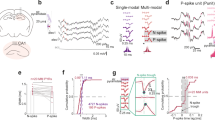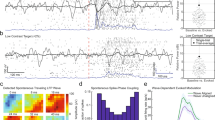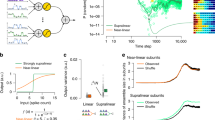Abstract
The conventional view of neurons is that synaptic inputs are integrated on a timescale of milliseconds to seconds in the dendrites, with action potential initiation occurring in the axon initial segment. We found a much slower form of integration that leads to action potential initiation in the distal axon, well beyond the initial segment. In a subset of rodent hippocampal and neocortical interneurons, hundreds of spikes, evoked over minutes, resulted in persistent firing that lasted for a similar duration. Although axonal action potential firing was required to trigger persistent firing, somatic depolarization was not. In paired recordings, persistent firing was not restricted to the stimulated neuron; it could also be produced in the unstimulated cell. Thus, these interneurons can slowly integrate spiking, share the output across a coupled network of axons and respond with persistent firing even in the absence of input to the soma or dendrites.
This is a preview of subscription content, access via your institution
Access options
Subscribe to this journal
Receive 12 print issues and online access
$209.00 per year
only $17.42 per issue
Buy this article
- Purchase on Springer Link
- Instant access to full article PDF
Prices may be subject to local taxes which are calculated during checkout







Similar content being viewed by others
References
Ramon y Cajal, S. Histology of the Nervous System of Man and Vertebrates (Oxford University Press, New York, 1995).
Devor, M. Unexplained peculiarities of the dorsal root ganglion. Pain 6, S27–S35 (1999).
Grimes, W.N., Zhang, J., Graydon, C.W., Kachar, B. & Diamond, J.S. Retinal parallel processors: more than 100 independent microcircuits operate within a single interneuron. Neuron 65, 873–885 (2010).
Shepherd, G.M., Chen, W.R., Willhite, D., Migliore, M. & Greer, C.A. The olfactory granule cell: from classical enigma to central role in olfactory processing. Brain Res. Rev. 55, 373–382 (2007).
Stuart, G., Spruston, N., Sakmann, B. & Häusser, M. Action potential initiation and backpropagation in neurons of the mammalian CNS. Trends Neurosci. 20, 125–131 (1997).
Bucher, D., Thirumalai, V. & Marder, E. Axonal dopamine receptors activate peripheral spike initiation in a stomatogastric motor neuron. J. Neurosci. 23, 6866–6875 (2003).
Goaillard, J.-M., Schulz, D.J., Kilman, V.L. & Marder, E. Octopamine modulates the axons of modulatory projection neurons. J. Neurosci. 24, 7063–7073 (2004).
Meyrand, P., Weimann, J.M. & Marder, E. Multiple axonal spike initiation zones in a motor neuron: serotonin activation. J. Neurosci. 12, 2803–2812 (1992).
Pinault, D. Backpropagation of action potentials generated at ectopic axonal loci: hypothesis that axon terminals integrate local environmental signals. Brain Res. Brain Res. Rev. 21, 42–92 (1995).
Heintz, N. Gene expression nervous system atlas (GENSAT). Nat. Neurosci. 7, 483 (2004).
Klausberger, T. & Somogyi, P. Neuronal diversity and temporal dynamics: the unity of hippocampal circuit operations. Science 321, 53–57 (2008).
Klausberger, T. et al. Complementary roles of cholecystokinin- and parvalbumin-expressing GABAergic neurons in hippocampal network oscillations. J. Neurosci. 25, 9782–9793 (2005).
Cruikshank, S.J. et al. Potent block of Cx36 and Cx50 gap junction channels by mefloquine. Proc. Natl. Acad. Sci. USA 101, 12364–12369 (2004).
Tovar, K.R., Maher, B.J. & Westbrook, G.L. Direct actions of carbenoxolone on synaptic transmission and neuronal membrane properties. J. Neurophysiol. 102, 974–978 (2009).
Hestrin, S. & Galarreta, M. Electrical synapses define networks of neocortical GABAergic neurons. Trends Neurosci. 28, 304–309 (2005).
Schmitz, D. et al. Axo-axonal coupling: a novel mechanism for ultrafast neuronal communication. Neuron 31, 831–840 (2001).
Bullock, T.H. et al. Neuroscience. The neuron doctrine, redux. Science 310, 791–793 (2005).
Fields, R.D. Oligodendrocytes changing the rules: action potentials in glia and oligodendrocytes controlling action potentials. Neuroscientist 14, 540–543 (2008).
Halassa, M.M. & Haydon, P.G. Integrated brain circuits: astrocytic networks modulate neuronal activity and behavior. Annu. Rev. Physiol. 72, 335–355 (2010).
Major, G. & Tank, D. Persistent neural activity: prevalence and mechanisms. Curr. Opin. Neurobiol. 14, 675–684 (2004).
Kullmann, D.M. Presynaptic kainate receptors in the hippocampus: slowly emerging from obscurity. Neuron 32, 561–564 (2001).
Semyanov, A. & Kullmann, D.M. Kainate receptor–dependent axonal depolarization and action potential initiation in interneurons. Nat. Neurosci. 4, 718–723 (2001).
Keros, S. & Hablitz, J.J. Ectopic action potential generation in cortical interneurons during synchronized GABA responses. Neuroscience 131, 833–842 (2005).
MacVicar, B.A. & Dudek, F.E. Electrotonic coupling between pyramidal cells: a direct demonstration in rat hippocampal slices. Science 213, 782–785 (1981).
Epsztein, J., Lee, A.K., Chorev, E. & Brecht, M. Impact of spikelets on hippocampal CA1 pyramidal cell activity during spatial exploration. Science 327, 474–477 (2010).
Bartos, M. et al. Fast synaptic inhibition promotes synchronized gamma oscillations in hippocampal interneuron networks. Proc. Natl. Acad. Sci. USA 99, 13222–13227 (2002).
McBain, C.J. & Fisahn, A. Interneurons unbound. Nat. Rev. Neurosci. 2, 11–23 (2001).
Lisman, J.E. et al. Circuit-based framework for understanding neurotransmitter and risk gene interactions in schizophrenia. Trends Neurosci. 31, 234–242 (2008).
Durstewitz, D., Seamans, J.K. & Sejnowski, T.J. Neurocomputational models of working memory. Nat. Neurosci. 3 Suppl, 1184–1191 (2000).
Egorov, A.V., Hamam, B.N., Fransén, E., Hasselmo, M.E. & Alonso, A.A. Graded persistent activity in entorhinal cortex neurons. Nature 420, 173–178 (2002).
Hines, M.L. & Carnevale, N.T. The NEURON simulation environment. Neural Comput. 9, 1179–1209 (1997).
Erisir, A., Lau, D., Rudy, B. & Leonard, C.S. Function of specific K(+) channels in sustained high-frequency firing of fast-spiking neocortical interneurons. J. Neurophysiol. 82, 2476–2489 (1999).
Acknowledgements
We thank T. Klausberger, S. Layton and M. Wilson for providing in vivo spiking data, and M. Benton, M. Nusbaum and members of the Spruston laboratory for helpful discussion and comments on the manuscript. We also thank E. Grodinsky for interneuron reconstructions. Grant support was provided by the US National Institutes of Health (NS-046064 to N.S. and W.L.K.) and the National Alliance for Research on Schizophrenia and Depression (N.S.). M.E.J.S. was supported by a Presidential Fellowship from Northwestern University.
Author information
Authors and Affiliations
Contributions
All authors participated in the design of the experiments and the analysis and interpretation of the data. M.E.J.S. and T.K.B. performed the experiments. W.L.K. performed the simulations. N.S. and B.D.M. wrote the manuscript with input from the other authors.
Corresponding author
Ethics declarations
Competing interests
The authors declare no competing financial interests.
Supplementary information
Supplementary Text and Figures
Supplementary Figures 1–7 and Supplementary Table 1 (PDF 5441 kb)
Supplementary Movie 1
Simple model of axonal action potential propagation in a stylized axon. (MOV 5750 kb)
Supplementary Movie 2
Model of axonal action potential propagation in a full morphological model. (MOV 11319 kb)
Rights and permissions
About this article
Cite this article
Sheffield, M., Best, T., Mensh, B. et al. Slow integration leads to persistent action potential firing in distal axons of coupled interneurons. Nat Neurosci 14, 200–207 (2011). https://doi.org/10.1038/nn.2728
Received:
Accepted:
Published:
Issue Date:
DOI: https://doi.org/10.1038/nn.2728
This article is cited by
-
Astrocytes integrate and drive action potential firing in inhibitory subnetworks
Nature Communications (2018)
-
Electrical coupling between hippocampal neurons: contrasting roles of principal cell gap junctions and interneuron gap junctions
Cell and Tissue Research (2018)
-
Electrical synapses convey orientation selectivity in the mouse retina
Nature Communications (2017)
-
Robust neuronal dynamics in premotor cortex during motor planning
Nature (2016)
-
Electrical Identification and Selective Microstimulation of Neuronal Compartments Based on Features of Extracellular Action Potentials
Scientific Reports (2016)



